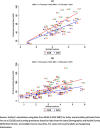Rethinking policy perspectives on childhood stunting: time to formulate a structural and multifactorial strategy
- PMID: 27187918
- PMCID: PMC5084745
- DOI: 10.1111/mcn.12254
Rethinking policy perspectives on childhood stunting: time to formulate a structural and multifactorial strategy
Abstract
Stunting and chronic undernutrition among children in South Asia remain a major unresolved global health issue. There are compelling intrinsic and moral reasons to ensure that children attain their optimal growth potential facilitated via promotion of healthy living conditions. Investments in efforts to ensure that children's growth is not faltered also have substantial instrumental benefits in terms of cognitive and economic development. Using the case of India, we critique three prevailing approaches to reducing undernutrition among children: an over-reliance on macroeconomic growth as a potent policy instrument, a disproportionate focus on interpreting undernutrition as a demand-side problem and an over-reliance on unintegrated single-factorial (one at a time) approaches to policy and research. Using existing evidence, we develop a case for support-led policy approach with a focus on integrated and structural factors to addressing the problem of undernutrition among children in India. Key messages Eliminating child undernutrition is important from an intrinsic perspective and offers considerable instrumental benefits to individual and society. Evidence suggests that an exclusive reliance on a growth-mediated strategy to eliminate stunting needs to be reconsidered, suggesting the need for a substantial support-led strategy. Interpreting and addressing undernutrition as a demand-side problem with proximal single-factorial interventions is futile. There is an urgent need to develop interventions that address the broader structural and upstream causes of child undernutrition.
Keywords: India; childhood; cognition; economic growth; multifactorial; social determinants; stunting; support-led strategy; undernutrition; upstream interventions.
© 2016 The Authors. Maternal & Child Nutrition published by John Wiley & Sons Ltd.
Conflict of interest statement
The authors declare that they have no conflicts of interest.
Figures





Similar articles
-
Understanding the null-to-small association between increased macroeconomic growth and reducing child undernutrition in India: role of development expenditures and poverty alleviation.Matern Child Nutr. 2016 May;12 Suppl 1(Suppl 1):196-209. doi: 10.1111/mcn.12256. Matern Child Nutr. 2016. PMID: 27187916 Free PMC article.
-
Can water, sanitation and hygiene help eliminate stunting? Current evidence and policy implications.Matern Child Nutr. 2016 May;12 Suppl 1(Suppl 1):91-105. doi: 10.1111/mcn.12258. Matern Child Nutr. 2016. PMID: 27187910 Free PMC article. Review.
-
A review of the evidence linking child stunting to economic outcomes.Int J Epidemiol. 2017 Aug 1;46(4):1171-1191. doi: 10.1093/ije/dyx017. Int J Epidemiol. 2017. PMID: 28379434 Free PMC article. Review.
-
Relative importance of 13 correlates of child stunting in South Asia: Insights from nationally representative data from Afghanistan, Bangladesh, India, Nepal, and Pakistan.Soc Sci Med. 2017 Aug;187:144-154. doi: 10.1016/j.socscimed.2017.06.017. Epub 2017 Jun 16. Soc Sci Med. 2017. PMID: 28686964
-
Risk factors for chronic undernutrition among children in India: Estimating relative importance, population attributable risk and fractions.Soc Sci Med. 2016 May;157:165-85. doi: 10.1016/j.socscimed.2015.11.014. Epub 2015 Nov 14. Soc Sci Med. 2016. PMID: 26625852
Cited by
-
Evaluating Changes in Determinants of Stunting among Children Under 2 Years and Assessing Their Contribution to Socioeconomic Disparity in Child Nutritional Status across India.Indian J Community Med. 2022 Jan-Mar;47(1):96-103. doi: 10.4103/ijcm.ijcm_1173_21. Epub 2022 Mar 16. Indian J Community Med. 2022. PMID: 35368472 Free PMC article.
-
Household food insecurity and early childhood development: Longitudinal evidence from Ghana.PLoS One. 2020 Apr 3;15(4):e0230965. doi: 10.1371/journal.pone.0230965. eCollection 2020. PLoS One. 2020. PMID: 32243485 Free PMC article.
-
Socio-economic, environmental and nutritional characteristics of urban and rural South Indian women in early pregnancy: findings from the South Asian Birth Cohort (START).Public Health Nutr. 2018 Jun;21(8):1554-1564. doi: 10.1017/S1368980017004025. Epub 2018 Feb 5. Public Health Nutr. 2018. PMID: 29400265 Free PMC article.
-
Towards a capability approach to child growth: A theoretical framework.Matern Child Nutr. 2018 Apr;14(2):e12534. doi: 10.1111/mcn.12534. Epub 2017 Oct 20. Matern Child Nutr. 2018. PMID: 29052943 Free PMC article. Review.
-
Precision mapping child undernutrition for nearly 600,000 inhabited census villages in India.Proc Natl Acad Sci U S A. 2021 May 4;118(18):e2025865118. doi: 10.1073/pnas.2025865118. Proc Natl Acad Sci U S A. 2021. PMID: 33903246 Free PMC article.
References
-
- Adair L.S., Fall C.H.D., Osmond C., Stein A.D., Martorell R., Ramirez‐Zea M. et al. (2013) Associations of linear growth and relative weight gain during early life with adult health and human capital in countries of low and middle income: findings from five birth cohort studies. The Lancet 382 (9891), 525–534. - PMC - PubMed
-
- Agarwal K.N., Agarwal D.K. & Benakapa D.G. (1991) Growth performance of affluent Indian children. Nutrition Foundation of India, Scientific Report 11.
-
- Aguayo V., Singh G. & Badgaiyan N. (2014) Scoring child nutrition in India measuring the performance of states. Economic & Political Weekly 49 (14), 97–103.
-
- Alderman H., Haddad L., Headey D.D. & Smith L. (2014) Association between economic growth and early childhood nutrition. The Lancet Global Health 2 (9), 500. - PubMed
-
- Basu K. & Maertens A. (2007) The pattern and causes of economic growth in India. Oxford Review Economic Policy 23 (2), 143–167. DOI: 10.1093/oxrep/grm012. - DOI
MeSH terms
LinkOut - more resources
Full Text Sources
Other Literature Sources
Medical

